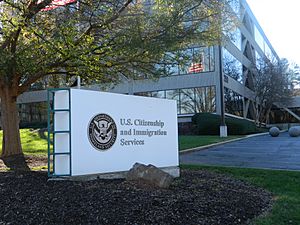United States Citizenship and Immigration Services facts for kids

USCIS logo
|
|
| Agency overview | |
|---|---|
| Formed | March 1, 2003 |
| Jurisdiction | Federal government of the United States |
| Headquarters | 5900 Capital Gateway Drive Camp Springs, Maryland, U.S. |
| Employees | 24,200+ (2025) |
| Annual budget | $6.81 billion (2025) |
| Agency executives |
|
| Parent agency | United States Department of Homeland Security |
| Key document |
|
The United States Citizenship and Immigration Services (USCIS) is an important agency in the United States Department of Homeland Security (DHS). Its main job is to manage how people become citizens and how they immigrate to the United States. USCIS helps people who want to live, work, or study in the U.S. legally.
Contents
History of USCIS
USCIS was created on March 1, 2003. It took over many of the jobs of an older agency called the Immigration and Naturalization Service (INS). The INS was split into three new parts within the Department of Homeland Security. These parts were USCIS, Immigration and Customs Enforcement (ICE), and Customs and Border Protection (CBP). This change happened because of the Homeland Security Act of 2002.
What is the USCIS Mission?
On February 9, 2022, USCIS updated its mission statement. The director, Ur Jaddou, announced this change. The new mission statement was created with ideas from USCIS employees. It also reflects the goals of the current government and the director's vision. The new mission statement shows that USCIS wants to be a welcoming and fair agency for everyone.
The mission statement says:
USCIS upholds America's promise as a nation of welcome and possibility with fairness, integrity, and respect for all we serve.
What USCIS Does
USCIS handles many important applications for people who want to come to or stay in the U.S. These include:
- Processing requests for immigrant visas.
- Helping people apply to become U.S. citizens.
- Reviewing applications for asylum (protection for people who fear harm in their home country).
- Processing applications for "green cards," which allow people to become permanent residents.
- Handling applications for refugee status.
USCIS also manages other immigration benefits. For example, they issue documents that allow people to work in the U.S. (called employment authorization documents or EADs). They also approve requests for temporary workers, like those with H-1B or O-1 visas.
A big goal for USCIS is to process these applications faster and more efficiently. They try to reduce how long people have to wait. They also offer customer service in different ways. You can contact them through their Contact Center, which has information in English and Spanish. They also have Application Support Centers and a helpful website.
USCIS helps people on their journey to becoming part of the U.S. community. This includes when they first become permanent residents. It also includes when they are ready to start the process of becoming a U.S. citizen.
Becoming a U.S. Citizen
If you are a lawful permanent resident, you can usually apply to become a U.S. citizen after living in the U.S. for at least five continuous years. This means you haven't left the country for 180 days or more at a time.
If a lawful permanent resident marries a U.S. citizen, they might be able to apply for citizenship sooner. They can apply after three years, as long as they have lived with their spouse for those three years. Also, their spouse must have been a U.S. citizen for at least three years.
USCIS Forms
USCIS uses special forms for all immigration and naturalization requests. These forms have a specific name and a code, like a letter followed by numbers.
- Forms related to immigration usually start with an "I." An example is I-551, which is the Permanent Resident Card (often called a "green card").
- Forms related to becoming a citizen (naturalization) usually start with an "N." An example is Form N-400, which is the Application for Naturalization.
Leaders of USCIS
The head of USCIS is called the Director. The Director helps guide the agency and make sure it carries out its mission.
Immigration Courts
It's important to know that USCIS is different from immigration courts. The United States immigration courts and the judges who work there are part of the United States Department of Justice. USCIS is part of the Department of Homeland Security. Immigration courts handle cases where people might be removed from the U.S., while USCIS handles applications for benefits like visas and citizenship.
How USCIS Operates
USCIS Website
USCIS has an official website that was updated in 2009. It helps people find information and get answers to their questions. The website even has a virtual assistant named Emma, who can answer questions in English and Spanish.
Getting Help from USCIS
The USCIS website has tools to help you. You can check the status of your case or change your address online. If you have questions about your case, or if you haven't received a document, you can submit an inquiry on the website. These inquiries go to the right USCIS office for help.
If the website tools don't solve your problem, you can call the USCIS Contact Center. If they can't help directly, they will send your issue to the correct office. People outside the U.S. can also schedule appointments through the website.
How USCIS is Funded
Unlike many other government agencies, USCIS gets most of its money from fees. These are fees that people pay when they apply for immigration benefits or citizenship. In 2020, most of USCIS's budget came from these fees. A smaller part came from money approved by Congress.
USCIS Offices
USCIS has many offices around the world.
- Field offices in the U.S. hold interviews for many types of cases. They also host naturalization ceremonies where people become citizens.
- Asylum offices focus specifically on interviews for asylum cases. They do not provide general information services.
- International offices help U.S. citizens and permanent residents who are living or visiting outside the United States.
See also
 In Spanish: Servicio de Ciudadanía e Inmigración de los Estados Unidos para niños
In Spanish: Servicio de Ciudadanía e Inmigración de los Estados Unidos para niños
- Visa policy of the United States
- H-1B Visa
- Permanent residence (United States) ("Green card")
- Visa Waiver Program
- Other major U.S. immigration agencies:
- U.S. Customs and Border Protection (CBP)
- U.S. Immigration and Customs Enforcement (ICE)
Similar Agencies in Other Countries
- Immigration, Refugees and Citizenship Canada
- Irish Naturalisation and Immigration Service
- Bureau of Immigration (India)
- Directorate General of Immigration (Indonesia)
- UK Visas and Immigration
Images for kids














